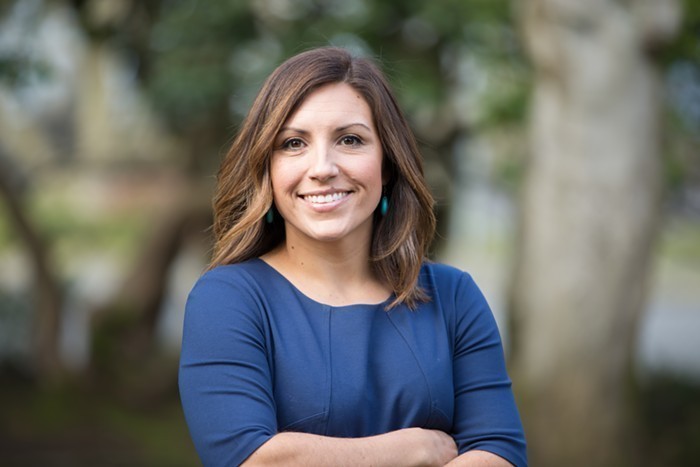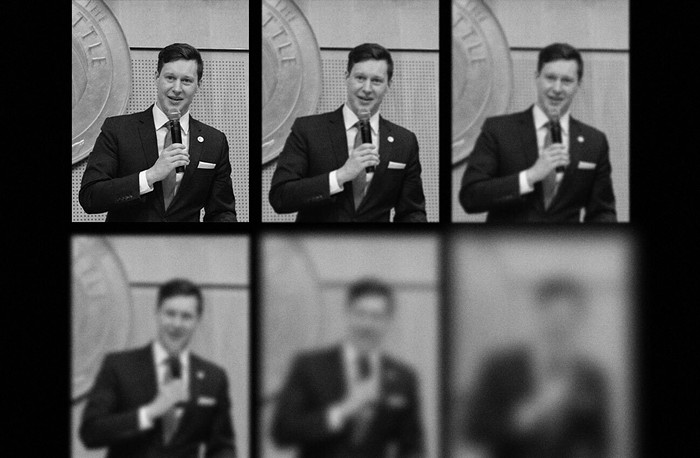When Mayor Ed Murray released a proposed 2015–2016 budget on September 22, one portion in particular made a lot of headlines: his plan to hire 100 new police officers by the end of his term. Noting in his budget speech that “Seattle has more people than at any point in its history, but the number of fully trained officers has actually decreased in recent years,” Murray pledged to make good on a campaign promise of adding 100 additional officers to the ranks of the Seattle Police Department. And he means new positions above and beyond attrition, his office says. Sounds great!
But what, exactly, does this uptick in officers mean? Where are these officers going to come from? What’s the precise timeline? As with lots of political promises, when you get deep into the math, things start to get a little confusing and new questions arise.
Take this year’s cop hiring, for example. Although the 2014 budget called for hiring 46 new officers, this year the city was able to hire only 33, due to “current hiring constraints,” says Murray spokesperson Jason Kelly. Those constraints, he explains, include “increased attrition, limited academy slots, [and] extended field training.” But by the end of this year, given how many officers are likely to have left the much-criticized, still-under-Justice-Department-supervision police force, the city estimates it’ll see a net gain of only 18 officers. To recap: The city planned to hire 46 officers this year, actually hired 33, and at the end of the year is likely to end up with only 18 more than it had before. That’s an achievement, but it still leaves 82 more officers to go over the next three years to meet Murray’s promise. Can it be done? Well…
The real promise, Murray spokesperson Jason Kelly says, is not just that the mayor will hire 100 new officers. It’s more specific—and harder to attain—than that. A mayor can say he’s “hired” a certain number of officers but still have those newly hired officers stuck in training, unable to be deployed, not out there helping anyone just yet. When Mayor Murray says 100 new officers, Kelly says, he’s talking about officers who are fully trained and ready to answer a call right now.
At the end of last year, Seattle had 1,264 “fully trained officers,” which means Murray needs to get the city to 1,364 fully trained officers by the end of his term in December of 2017. To achieve that aim requires a complex hiring plan that takes into account continued attrition, the requirements of attending the police academy, and the need to complete field training. This year’s experience—33 hires, many departures, and a net gain of only 18 trained officers—suggests how tricky it could be.
Murray’s office expects that departures at the department may continue, given all the change the SPD is going through, though not quite at this year’s rate. To stay on track, the mayoral plan is to allocate funding that’s expected to result in 31 new, fully trained officers by the end of 2015 (and again, that should be above and beyond however many officers leave or retire during the year).
For those keeping track: That’s a total of 49 new cops by the end of next year. Which means by halfway through Murray’s term, he’d be almost halfway to that 100 officer goal. Woo-hoo! Halfway! Almost!
But as this year showed, the intentions of budgets don’t always result in the numbers you want. And the basic challenges of academy training slots and the rate of attrition aren’t even the only hiring issues. SPD spokesman Sean Whitcomb says the department has a concern that goes beyond sheer numbers, and that’s the quality of new hires. Sure, they want to hire more people—100 more people sounds great. “People always want to see more police,” Whitcomb says. It’s the mayor’s job to allocate funding. But “our job, our challenge,” says Whitcomb, “is to get good quality people.”
You can set all kinds of numerical goals, but for a department under a federal consent decree because of a history of biased policing and excessive use of force, you also need to get new hires who are able to further the culture of police reform, not drag it screaming backward.
SPD wants to hire “not just any people,” says Whitcomb, “but the best, most qualified candidates. And people who really want to be in this city, people who want to serve this city and have a deep appreciation for Seattle.” (Quick translation: It’s better to hire a few great cops than a bunch of aggro anti-reformers.) “I can’t imagine working in another place,” Whitcomb says, “and that’s the kind of people we want to hire. It’s not just a job.”
All of which leads to another question. Say the department’s recruiters—who “are doing an awesome job,” Whitcomb says—are able to find plenty of people who fit the department’s current requirements. Say Murray makes good on his promise that, as he said in his speech, “by the end of 2016 we will have the highest number of fully trained officers in the Seattle Police Department’s history.” (The previous high-water mark, by the way, was in 2010, when the department had 1,330 fully trained officers. If Murray hits his targets, we’ll have 1,336 fully trained officers by 2016, which is just a tad more.) Anyway, say all of that happens—success!—and we wonder to ourselves: Well, we got 100 new officers, but is that number enough for a city this size?
To put it another way: Aside from hitting this numerical target, how will we know when we’ve hired “enough” new officers?
Turns out it’s hard for a city to know this. One metric that’s used is how many police officers there are compared with the number of people in the city. Right now, per capita, Seattle has about 20.5 officers per 10,000 citizens. In 2010, the high-water mark for fully trained officers, we had closer to 22 officers per 10,000 citizens. So even if we will have reached a higher number of officers in 2016, after you factor in population growth, we won’t actually be ahead, per capita, of earlier staffing levels.
But! National experts don’t seem to agree that counting officers per capita is the best staffing model, anyway. How many officers you need on beats in your city can vary widely, and it depends on concerns other than the population—like crime rates, for example.
SPD has focused instead on setting performance-based goals, like a seven-minute response time to the highest priority calls, or officers spending about 30 percent of their shifts patrolling their beat while not on a call. “Last time I checked,” says Whitcomb, the department was meeting those targets.
In other words, when it comes to police staffing, even though numbers are important, what those officers are doing and how well they’re serving the public can be a lot more important than a simple head count.
And even more important than this numbers game, perhaps, are promises Mayor Murray has made to focus on “data-driven policing”—implementing new software that can better track crimes and locations, reallocating resources to get more officers out on the streets in deployments that make more sense—as well as his and his new chief’s pledge to focus on community-oriented policing. That’s cops out of their cars, walking beats, connecting with the neighborhoods and communities they serve.
Maybe sometime after the push for better data is producing results, somewhere in the new streams of information the department will be getting, we’ll find out whether 100 new officers was too few, too much, or just right. ![]()


















